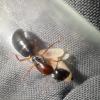I’m going to start this up as my first journal on here. (I hope that's not jinxing anything because none of these queens has made it through hibernation or laid any eggs yet) I found the three Crematogaster cerasi queens on Labor Day weekend 2018. I had biked out to a marina next to the Potomac River and found the queens crawling on a picnic table there. It was an open area with mature trees. I only had three containers, so a fourth one I found got away. I figure with three, at least one should work out. I didn't want them to get all jostled up biking home, so I called my wife to come pick me up. After a burger and a beer, we drove the girls home.
I put all three in test-tube set ups with a drop of honey and stored them in a shoebox in a closet. I checked on them every two weeks or so, and all looked well.
If these queens are successful, I will be giving them names from Norse mythology.
Here's a picture of one of the divas:
Edited by ANTdrew, November 25 2020 - 4:13 PM.
"The ants are a people not strong, yet they prepare their meat in the summer." Prov. 30:25
Keep ordinary ants in extraordinary ways.





















